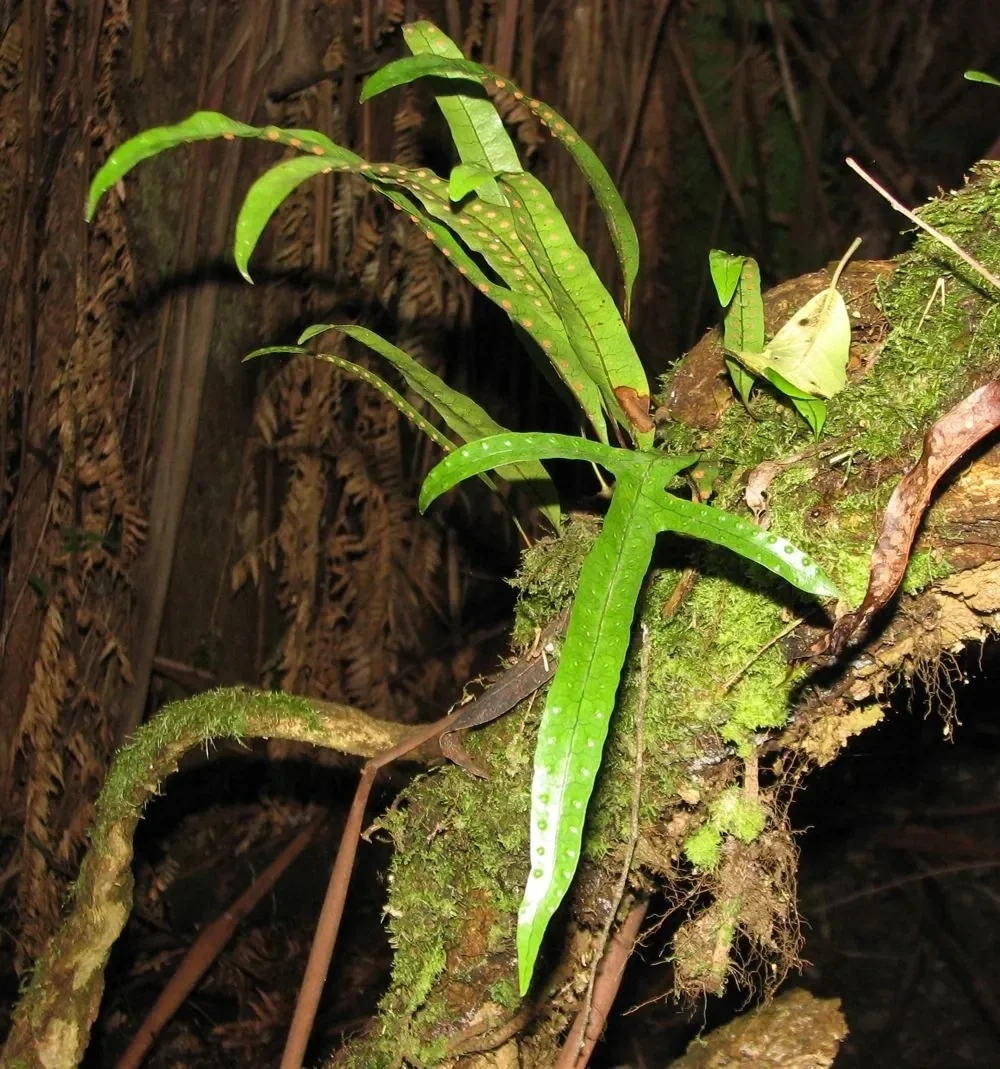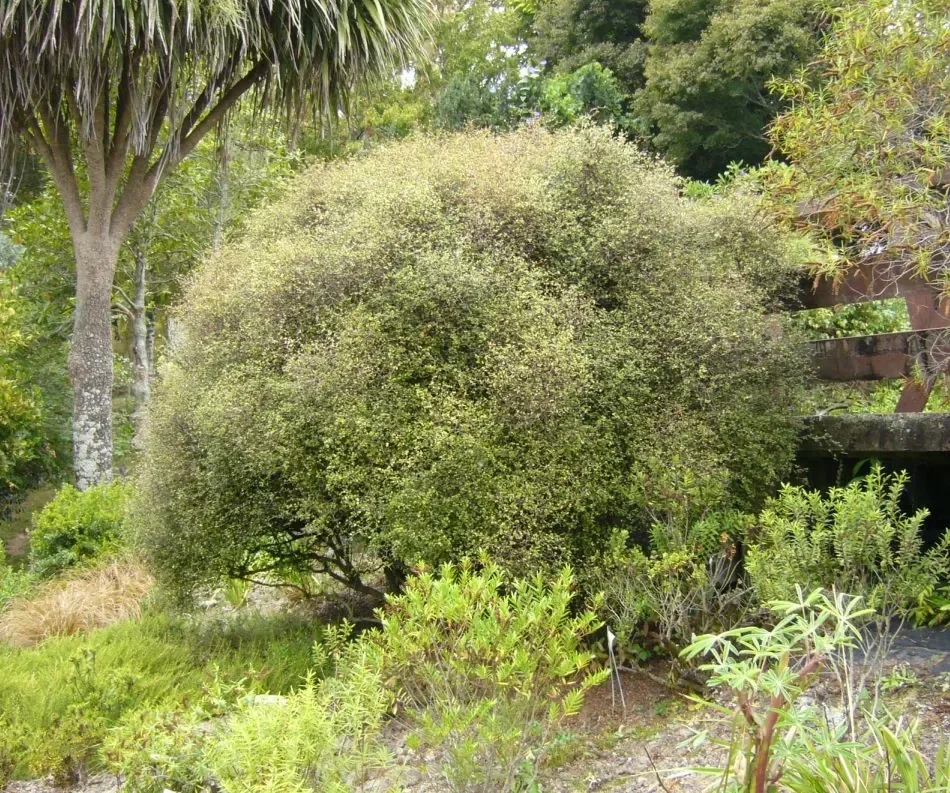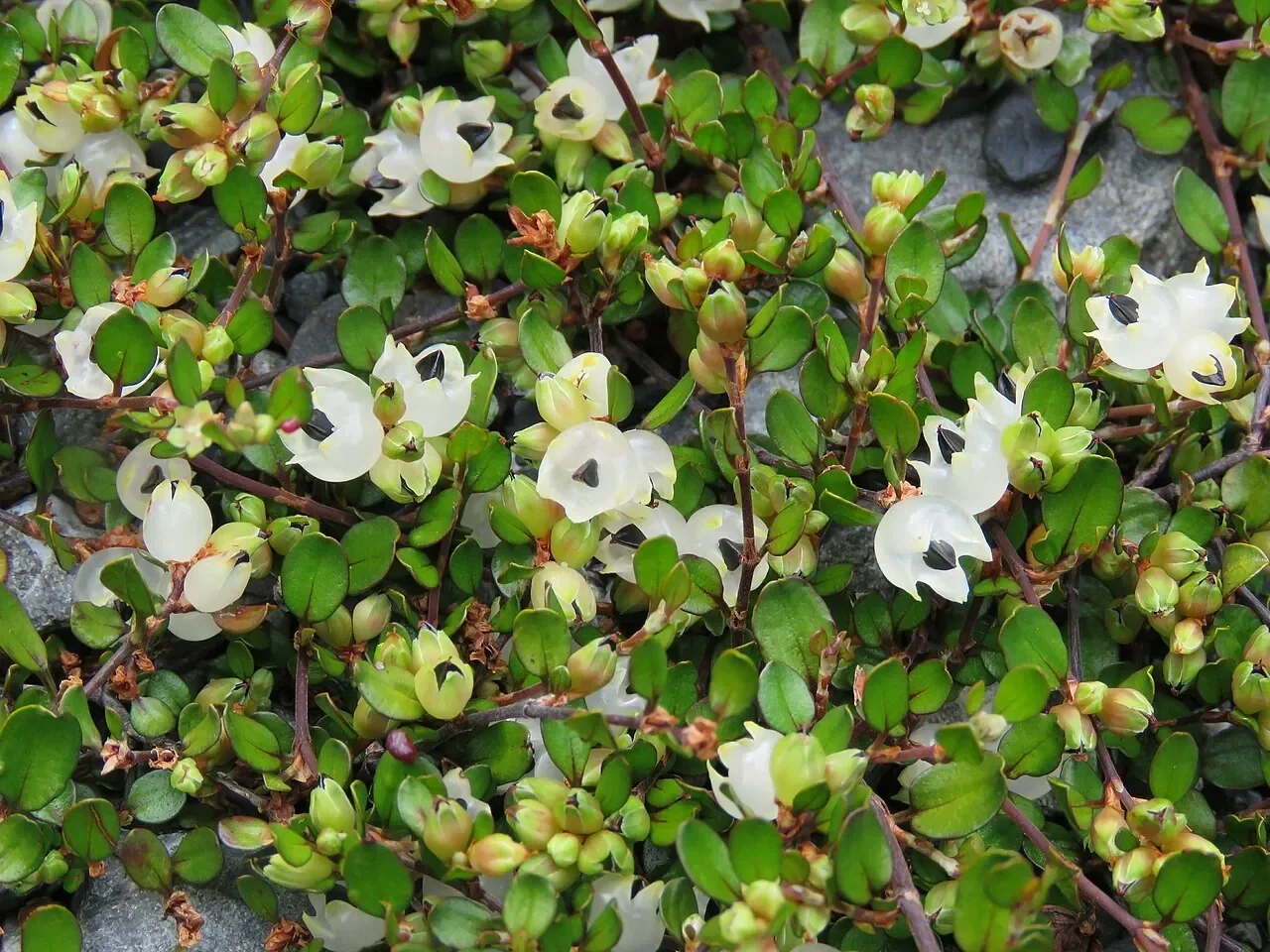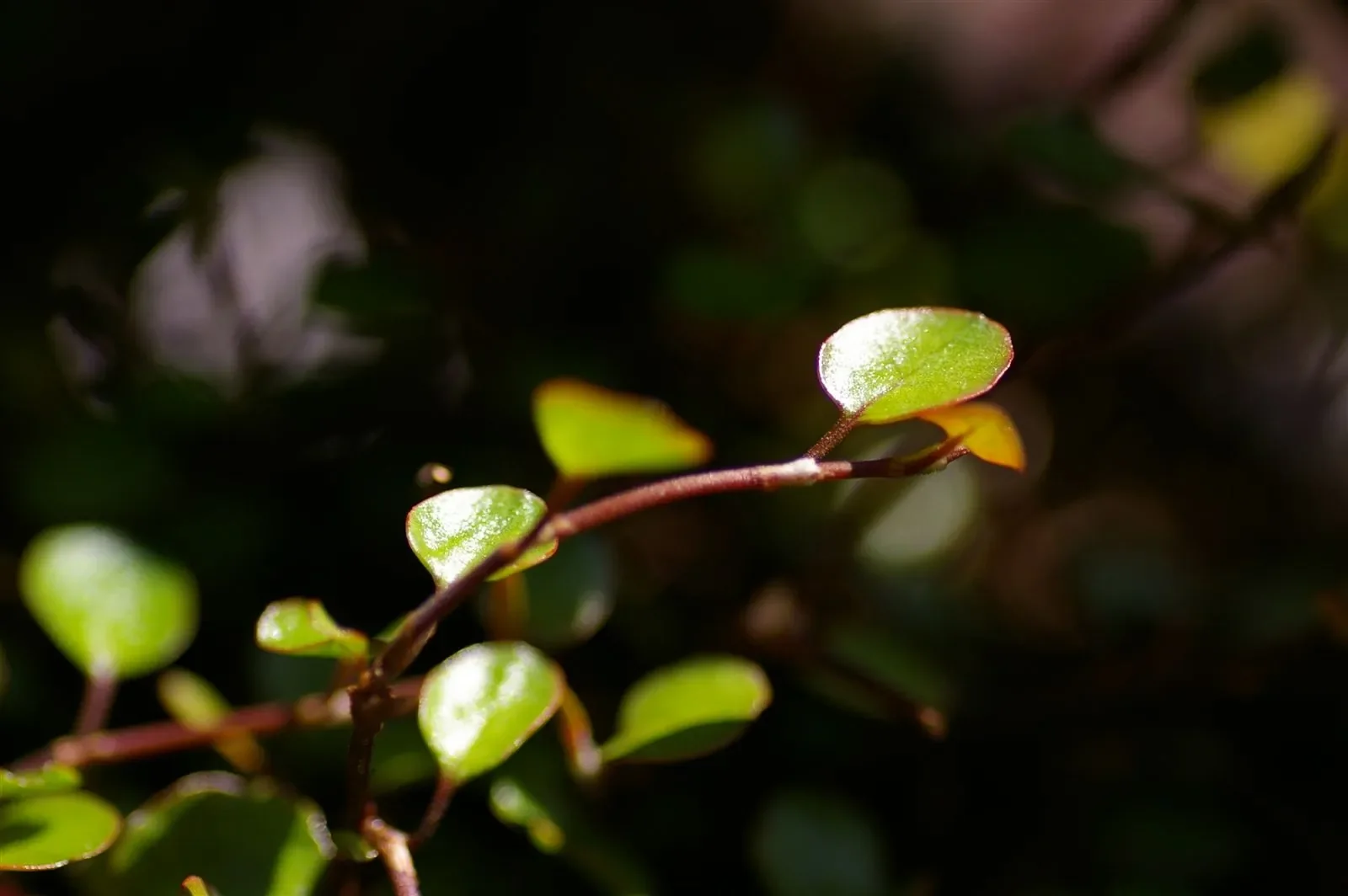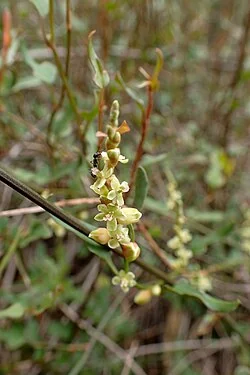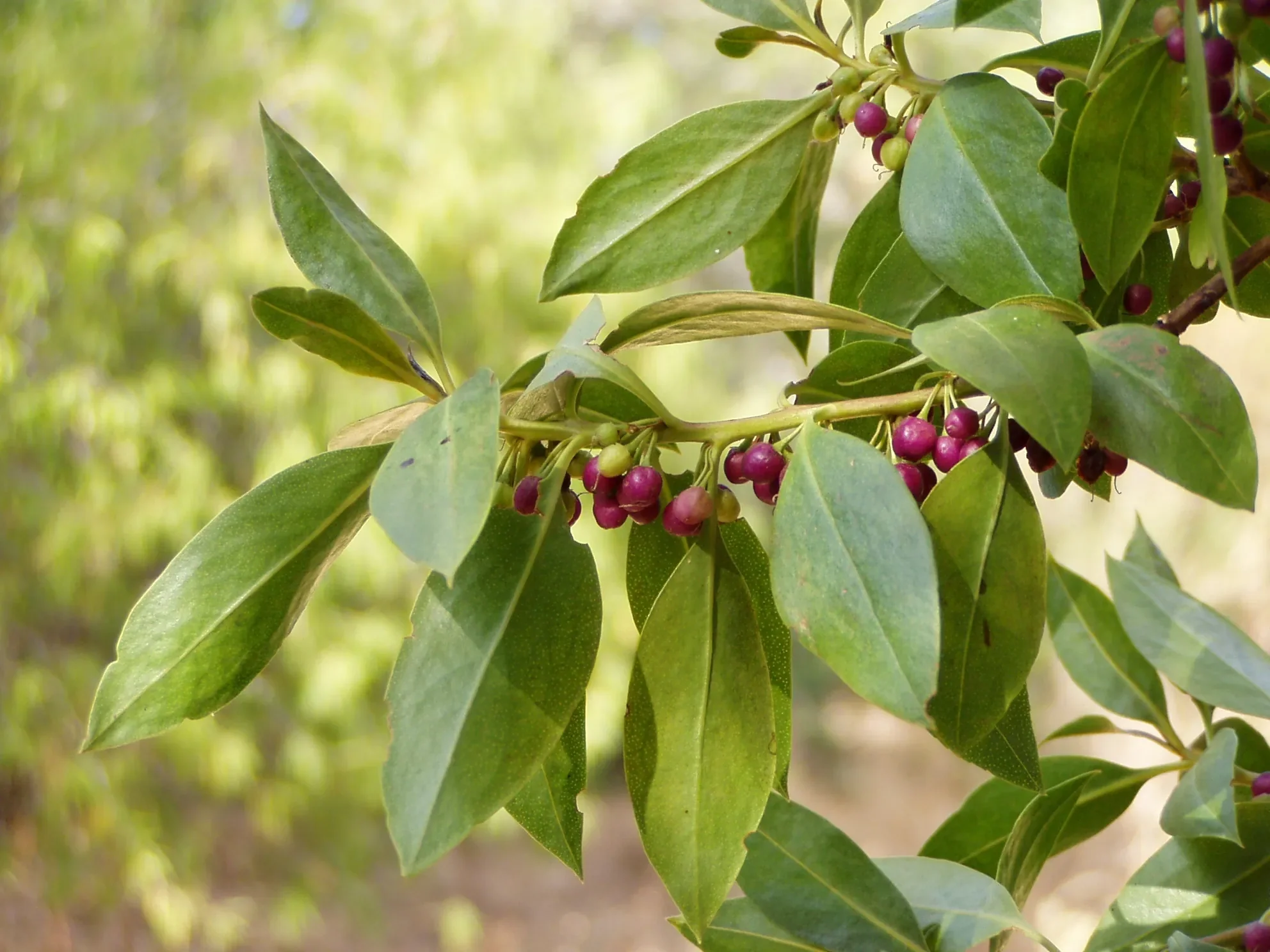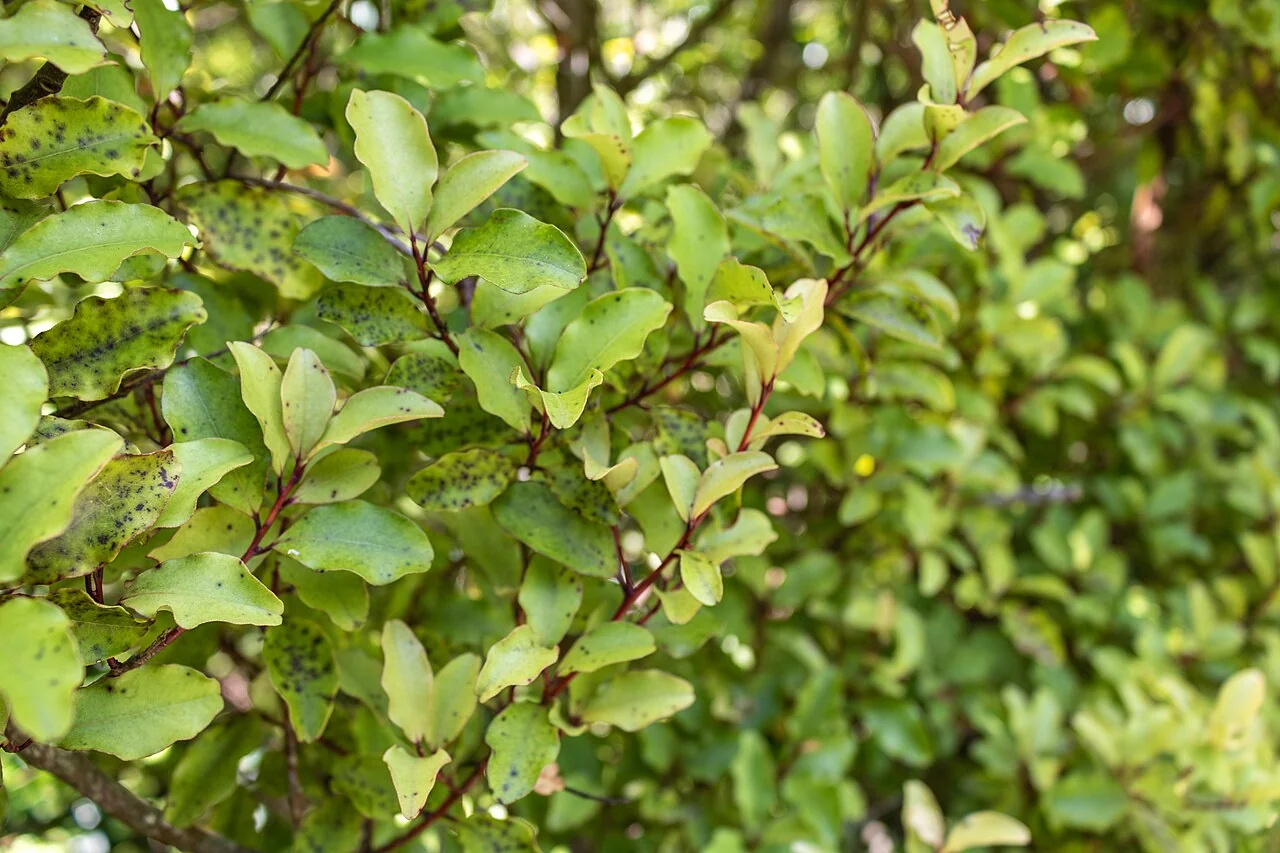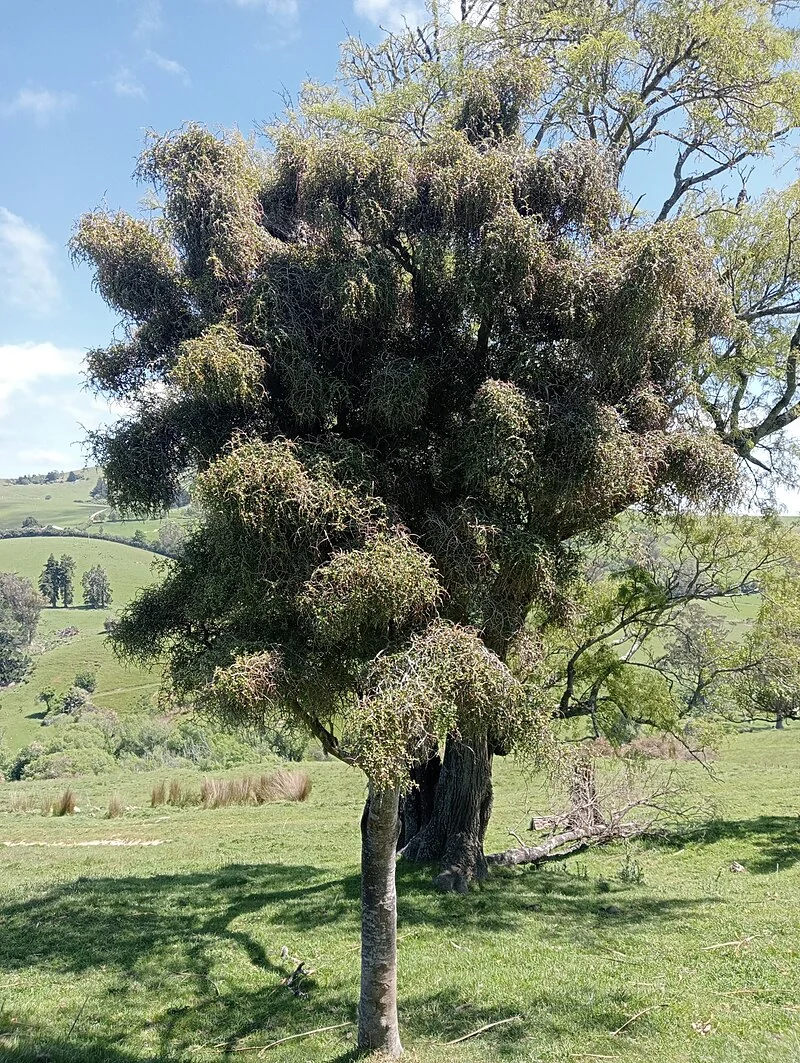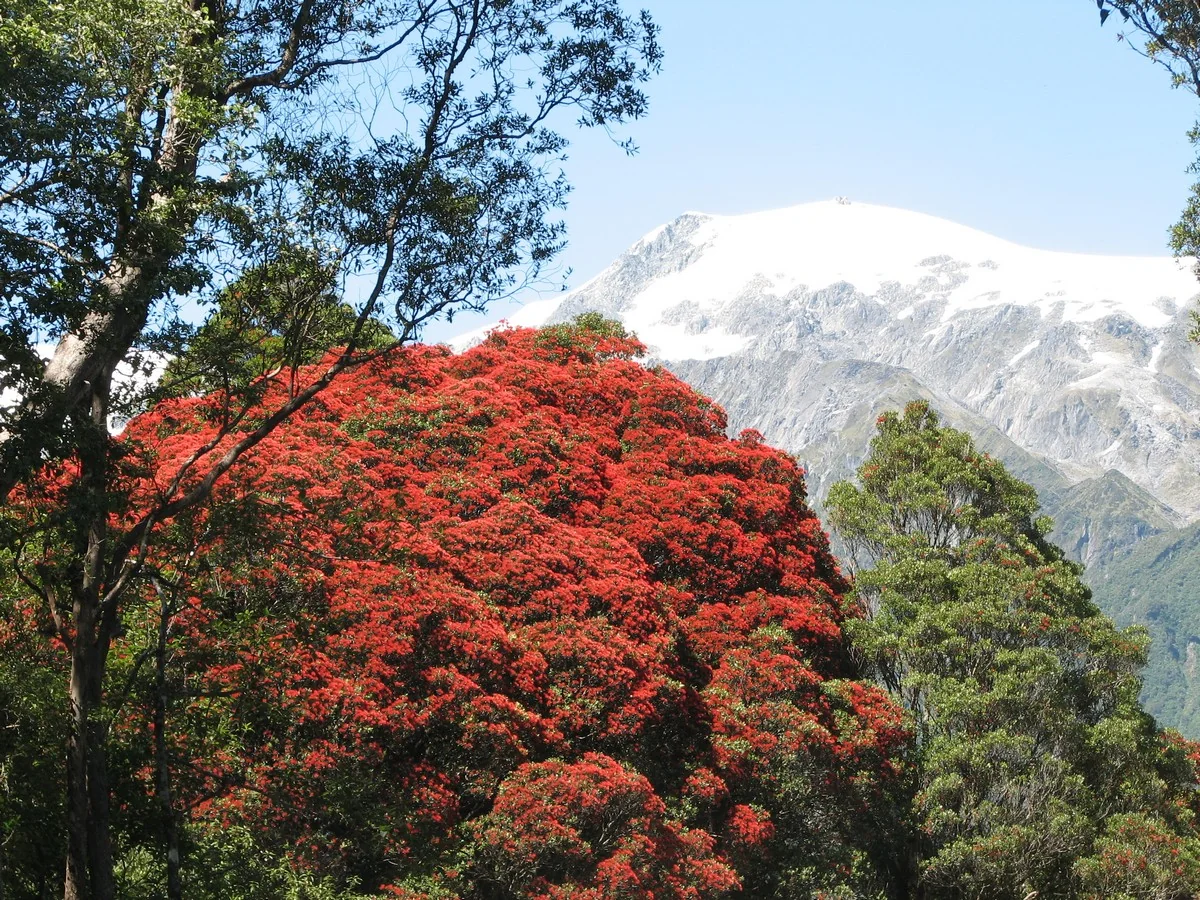
Southern Rātā
Metrosideros umbellata
Southern Rātā (Metrosideros umbellata) stands as one of New Zealand's most spectacular native flowering trees, renowned for its brilliant scarlet blooms that transform the forest canopy during summer. Endemic to the South Island and Stewart Island, this remarkable tree has evolved a unique life strategy, beginning as an epiphyte high in the forest canopy before sending aerial roots to the ground and eventually strangling its host. With massive trunks that can exceed 12 meters in diameter and towering heights reaching 25 meters, Southern Rātā represents one of New Zealand's most iconic forest giants. The species plays a crucial ecological role as a keystone canopy species and provides spectacular displays that make it highly valued in native tree cultivation and conservation.

Plant Description
Botanical Features
Southern Rātā (Metrosideros umbellata) is a tree endemic to New Zealand, growing up to 15 to 20 meters tall with a trunk up to 1 meter or more in diameter, though it can also appear as a bushy, multi-stemmed shrub in exposed areas. It produces abundant scarlet (red) flowers in summer, typically from December to February, though white or yellow variations exist. The leaves are evergreen, leathery, sharply pointed, and range from 3 to 6 centimeters in length. Young shoots and leaves often have a reddish tint. The bark is rough, flaky, and light grey or fawn brown, peeling off in thin strips. Its wood is known for being hard, dense, and very strong. This species thrives in cooler regions with high rainfall and is the most widespread of New Zealand's tree rātā species.
Quick Facts
| Scientific Name | Metrosideros umbellata |
|---|---|
| Height | 15-25 m |
| Spread | 15-20 m |
| Water Needs | High moisture, prefers humid conditions |
| Light | Full sun to partial shade |
| Frost Tolerance | Moderate, prefers mild conditions |
| Salt Tolerance | Low |
| Growth Rate | Slow to medium |
| Lifespan | Very long (500+ years) |
Climate Best Suited to
Southern Rātā (Metrosideros umbellata) naturally occurs in the cool, moist climate of the South Island's west coast and southern regions, where high rainfall and mild temperatures create ideal growing conditions. This species thrives in areas with consistent moisture and relatively stable temperatures year-round, preferring the humid conditions found in its native podocarp-broadleaf forests. The maritime influence and high rainfall of its natural range make it well-suited to areas with similar climatic conditions, though it can adapt to slightly drier environments once well-established.
Regional Suitability
| City | Climate Suitability |
|---|---|
| Whangārei | Good |
| Auckland | Good |
| Hamilton | Good |
| Tauranga | Moderate |
| Rotorua | Ideal |
| Gisborne | Moderate |
| New Plymouth | Ideal |
| Napier | Moderate |
| Whanganui | Good |
| Palmerston North | Good |
| Wellington | Ideal |
| Nelson | Good |
| Christchurch | Good |
| Dunedin | Ideal |
| Invercargill | Ideal |
Natural Habitat
Southern Rātā is found from coastal to montane areas in the North Island (from latitude 36° southwards), the South Island (more common in western areas), Stewart Island, and the Auckland Islands. It is a versatile tree, growing on well-lit banks, forest slopes, and rocky areas. It is a key species in many of New Zealand's temperate rainforests, particularly in areas with high rainfall.
Plant Conservation
Metrosideros umbellata, commonly known as southern rātā, is a tree species endemic to New Zealand. While it was classified as "Not Threatened" nationally in 2023, its conservation status was elevated to "Threatened - Nationally Vulnerable" in 2017 due to the significant risk posed by myrtle rust. The primary threats to Metrosideros umbellata include myrtle rust (Austropuccinia psidii), possum browsing (particularly in the North Island where the species is less common), and hybridization with northern rātā (Metrosideros robusta) in regions like the Tararua range. Southern rātā is widely distributed across New Zealand, found in the North and South Islands, Stewart Island, and the Auckland Islands, preferring cooler, high-rainfall environments. Conservation efforts, such as those by Project Crimson, aim to promote the conservation of rātā and related species like p� hutukawa.
Growing Requirements
Soil Requirements
Southern Rātā (Metrosideros umbellata) requires well-drained but consistently moist soils that remain cool and humid year-round. The species naturally grows in deep, organic-rich forest soils with excellent water retention capacity. In cultivation, it benefits from deep, humus-rich soils with good structure and drainage. The species cannot tolerate waterlogged conditions but requires consistent moisture availability throughout the year.
- Requires deep, humus-rich soils with excellent organic content
- Needs consistent moisture but with good drainage
- Prefers neutral to slightly acidic pH conditions
- Benefits from regular organic matter addition
- Heavy mulching essential to maintain soil moisture and temperature
Light Requirements
Southern Rātā (Metrosideros umbellata) performs best in full sun positions where it can develop its spectacular flowering displays, though it can tolerate partial shade particularly when young. In its natural habitat, mature trees emerge above the forest canopy to reach full sunlight. Good air circulation is important to prevent fungal issues, but protection from strong winds is beneficial during establishment.
- Prefers full sun for optimal flowering and growth
- Can tolerate partial shade, especially when establishing
- Requires good air circulation around the canopy
- Benefits from protection from strong winds when young
- At least 6 hours of direct sunlight daily for best flowering
Water Requirements
Southern Rātā (Metrosideros umbellata) has high water requirements, reflecting its adaptation to the high-rainfall environment of the South Island's west coast. The species requires consistent soil moisture throughout the year and benefits from high humidity levels. During dry periods, deep watering is essential to maintain the moist conditions this forest giant requires.
- High water requirements with consistent year-round moisture
- Requires deep, regular watering during dry periods
- Benefits from high humidity and moist air circulation
- Cannot tolerate drought conditions once established
- Mulching critical to maintain consistent soil moisture
Planting Guide
1. Ideal Growing Conditions:
- Sunlight: Southern Rata thrives in full sun to partial shade. It cannot grow in full shade.
- Soil: It prefers well-drained, moisture-retentive, lime-free soil. It can tolerate light (sandy), medium (loamy), and heavy (clay) soils, and prefers moist soil. While somewhat lime-tolerant, it is unsuitable for shallow soils over chalk.
- pH: Suitable for mildly acid, neutral, and mildly alkaline (basic) soils.
- Hardiness: Metrosideros umbellata is considered the most cold-hardy of the Metrosideros genus. It is hardy to UK zone 9 and can withstand temperatures down to 1°C (34°F). Young plants should be protected from frost.
- Tolerance: It is very resistant to maritime exposure and is also humidity tolerant. It prefers cooler, high-rainfall areas.
2. Planting:
- Growth Rate: Southern Rata has a slow to moderate growth rate, typically growing about 20-40 cm per year under good conditions. It can eventually reach heights of up to 15 meters or more over several decades.
- Spacing: When planting multiple trees, allow at least 4-6 meters of spacing between each to accommodate their mature spread and ensure healthy air circulation.
Ecological Role
Southern rātā (Metrosideros umbellata) is a key nectar tree of cool, high‑rainfall coastal and montane forests. Spectacular scarlet umbels supply energy to tūī, bellbirds and insects during summer, while its dense foliage and persistent leaf litter buffer wind and moisture, fostering shade‑tolerant understorey communities.
- Nectar hub: Supports bird and invertebrate food webs during peak flowering.
- Wind‑firm canopy: Stabilises slopes and shelterbelts in exposed southern and coastal habitats.
- Habitat host: Mature trees accumulate epiphytes and lichens; fallen branches enrich forest floor structure.
Uses and Significance
Garden Uses
- Outstanding specimen tree for large gardens and parks
- Spectacular summer flowering display with brilliant red blooms
- Impressive architectural presence with massive trunk
- Perfect for large-scale native plantings and restoration
- Creates dramatic focal points in landscape design
Conservation Value
As a long-lived forest giant, Southern Rātā (Metrosideros umbellata) plays a crucial role in conservation efforts for South Island forest ecosystems. Individual trees can live for over 500 years, making them important genetic reservoirs and ecosystem anchors. Cultivation and protection of this species contributes directly to maintaining New Zealand's forest biodiversity and provides crucial habitat for endangered native species.
- Long-lived genetic reservoir maintaining ecosystem stability
- Provides habitat for endangered native bird and plant species
- Important for forest ecosystem restoration and conservation
- Supports research into forest dynamics and climate adaptation
- Represents intact native forest communities
Landscaping Ideas
Cold-Hardy Rātā for Southern Gardens
- Feature tree: Stunning summer scarlet display; give space for a broad crown.
- Coastal/temperate plantings: Thrives in cool, moist, coastal climates with shelter from severe exposure.
- Habitat value: Nectar attracts birds; underplant with ferns and shade-tolerant natives.
Prefers deep, well-drained, moisture-retentive soils and full sun to light shade; steady summer moisture reduces bud drop in hotter districts.
Seasonal Care Calendar
Spring
Spring marks the beginning of active growth for Southern Rātā (Metrosideros umbellata), with new shoots emerging and flower buds beginning to develop. This is an excellent time for planting new specimens or conducting any necessary pruning. Ensure consistent moisture as growth resumes and apply organic fertilizer to support the upcoming flowering season.
- Active growth begins with new shoots and flower bud development
- Apply slow-release organic fertilizer to support flowering
- Ideal time for planting new specimens
- Ensure consistent soil moisture as growth resumes
- Light pruning can be done before active growth
Summer
Summer is the spectacular flowering season for Southern Rātā (Metrosideros umbellata), with brilliant scarlet blooms transforming the tree into a beacon of color from December through February. Maintain consistent moisture during this period of peak activity and monitor for signs of water stress during hot, dry weather.
- Peak flowering period with spectacular scarlet displays
- Maintain consistent moisture during peak growth
- Monitor for water stress during hot, dry periods
- Excellent time for enjoying and photographing flowers
- Increased bird activity around flowering trees
Autumn
During autumn, Southern Rātā (Metrosideros umbellata) completes its flowering cycle and begins seed development. This is an excellent time for seed collection if propagation is desired. Growth begins to slow as temperatures cool, but consistent moisture remains important for root development and establishment.
- Flowering completes and seed capsules develop
- Excellent time for seed collection for propagation
- Continue consistent watering as growth slows
- Good time for structural pruning if needed
- Apply additional mulch before winter
Winter
Winter is a relatively dormant period for Southern Rātā (Metrosideros umbellata), though the evergreen foliage continues to provide garden structure and wildlife habitat. Reduce watering but ensure soil doesn't dry out completely. This species shows good cold tolerance but benefits from protection from harsh winds in exposed locations.
- Dormant period with reduced growth activity
- Evergreen foliage provides continued structure and habitat
- Reduce watering but maintain soil moisture
- Good cold tolerance once established
- Protect from harsh winds in exposed locations
When to Prune and How Much
Southern Rātā (Metrosideros umbellata) naturally develops an impressive spreading form and requires minimal pruning to maintain its character. Focus on removing dead, damaged, or crossing branches and any light shaping needed for safety or specific garden applications. Given the species' ultimate size and slow growth, pruning should be conservative and planned carefully to preserve the tree's natural majesty.
- Remove dead, damaged, or diseased branches any time of year
- Light formative pruning when young helps establish good structure
- Major pruning best done in late winter during dormancy
- Remove crossing or rubbing branches to prevent damage
- Avoid heavy pruning which can affect the natural form
- Consider ultimate size when planning structural modifications
Always use clean, sharp pruning tools to minimize disease risk and ensure clean cuts. Given the species' potential for massive size, early formative pruning is more important than attempting to control size later in the tree's life. Professional arborist consultation is recommended for major pruning of established trees.
How to Grow Southern Rātā
Southern Rātā (Metrosideros umbellata) can be successfully propagated through several methods, with seed propagation being the most reliable when fresh seed is available, though cutting propagation can also be successful with proper care. Due to the species' slow growth and specific requirements, patience and attention to detail are essential for successful cultivation of this magnificent forest giant.
From Seed
Growing Southern Rātā from seed is the most reliable propagation method and allows for genetic diversity important for ecosystem restoration. Fresh seed offers the best germination rates and should be collected when capsules naturally split open.
- Collect ripe seed capsules from mature trees in late summer to autumn (February-April) when capsules begin to split naturally, revealing tiny seeds
- Extract seeds carefully from capsules as they are extremely small and can be easily lost
- Sow fresh seeds immediately on the surface of finely sieved seed-raising mix as they require light for germination
- Cover lightly with fine vermiculite or leave exposed on soil surface
- Maintain consistently moist conditions using misting rather than direct watering to avoid disturbing tiny seeds
- Provide bright, indirect light with temperatures around 18-22°C
- Germination can take several weeks to months and may be sporadic - patience is essential
- Transplant seedlings very carefully when they reach 5-8cm height and have developed several sets of true leaves
- Grow on in controlled conditions for at least two full seasons before considering outdoor planting
Seedlings grow slowly and require careful management during their early years, but this investment pays off with magnificent trees that can live for centuries.
From Semi-Hardwood Cuttings
Semi-hardwood cutting propagation can be successful with Southern Rātā and allows for the preservation of specific genetic characteristics, though success rates may be variable and require careful attention to environmental conditions.
- Take 10-15cm cuttings from healthy, current season's growth during late summer to early autumn (February-April) when wood has begun to firm
- Remove lower leaves, retaining only 2-3 pairs at the cutting tip to reduce moisture loss
- Make clean cuts just below a node using sharp, sterilized pruning shears
- Dip cut end in strong rooting hormone powder containing IBA to improve success rates
- Insert cuttings into sterile, free-draining propagation mix
- Maintain very high humidity using plastic covers or misting systems with temperatures around 20-25°C
- Provide bright, indirect light and maintain consistent but not waterlogged moisture
- Root development typically takes 8-16 weeks - test by gentle tugging
- Pot up rooted cuttings individually and grow on carefully for at least one season
- Gradually acclimatize young plants to outdoor conditions before transplanting
From Softwood Cuttings
Softwood cuttings taken from new spring growth can also be attempted, particularly when trying to multiply specific genetic forms, though this method requires even more careful environmental control.
- Select healthy, soft new growth during early to mid-spring (September-November)
- Take 8-12cm cuttings early morning when plant tissues are fully hydrated
- Remove lower leaves and treat with strong rooting hormone
- Insert into fine propagation medium and maintain very high humidity
- Provide gentle bottom heat and protection from direct sunlight
- Expect rooting within 6-12 weeks under optimal conditions
Transplanting and Establishment
Successful establishment of Southern Rātā requires careful site selection and long-term commitment to providing appropriate growing conditions for this slow-growing forest giant.
- Choose large planting sites with full sun exposure and protection from strong winds
- Prepare soil thoroughly by incorporating large amounts of organic matter and ensuring good drainage while maintaining moisture retention
- Plant at the same depth as in containers, avoiding any disturbance to the root system
- Water thoroughly after planting and maintain consistent soil moisture throughout the establishment period
- Apply thick organic mulch around plants to maintain soil moisture and temperature
- Provide stake support in windy locations until well established
- Monitor closely during first several years, providing supplemental water during dry periods
- Protect from browsing animals and mechanical damage during establishment
With proper care and patience, Southern Rātā establishes steadily and begins developing its characteristic form within 5-10 years of planting, eventually growing into one of New Zealand's most magnificent native trees that will provide spectacular displays for generations to come.
Pests and Diseases
Cool-Climate Advantages, Similar Risks
- Myrtle rust: Risk is lower in cooler regions but still monitor new flushes; maintain airflow.
- Scale/sooty mould: Manage with oils and canopy thinning.
- Wind breakage: Stake young trees in exposed sites; clean up storm damage promptly.
- Poor drainage: Avoid waterlogging to prevent decline.
Cultural Significance
Metrosideros umbellata, commonly known as Southern Rātā, holds significant cultural importance, particularly for the Māori people of New Zealand.
Key Aspects of Its Cultural Significance Include:
- Traditional Māori Uses: The dark red timber of the rātā was highly valued for carving. Māori also utilized the wood for crafting weapons such as the taiaha and paiaka (also known as tewhatewha). Its roots were shaped into groper hooks, and clubs made from rātā wood were employed in seal hunting. Additionally, rātā bark was traditionally used for treating cuts and wounds.
- Timber and Construction: The wood of Metrosideros umbellata is known for being compact, tough, and very strong. Historically, it was used in ship-making and carpentry. During the early settlement of New Zealand, southern rātā wood was specifically used for shipbuilding. Today, if available, it finds use in coach work and as cross-arms for telephone poles.
- Ecological and Economic Value: Southern Rātā is a crucial source of honey, particularly on the West Coast of New Zealand's South Island. Its abundant nectar attracts native birds like tui, bellbirds, and kaka.
- Ornamental and Symbolic Value: The tree is admired for its vibrant red flowers that bloom in summer and its dense, glossy foliage, making it a popular ornamental plant. Along with the pohutukawa, rātā is sometimes referred to as a "New Zealand Christmas tree" because of its striking red blossoms appearing around the Christmas season.
Bonus Tip
Southern rātā (Metrosideros umbellata) is the most cold-hardy rātā. In warm summer areas it benefits from a little afternoon shade and deep summer watering during dry spells to prevent bud drop, ensuring the breathtaking red canopies in mid-late summer.
